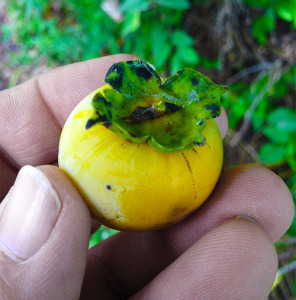 The word persimmon usually conjurers up one of two reactions when brought up. The most common result is that of the serious pucker factor when tricked into biting into a green fruit. But to those that know, the memory of a sweet, succulent fruit comes to mind.
The word persimmon usually conjurers up one of two reactions when brought up. The most common result is that of the serious pucker factor when tricked into biting into a green fruit. But to those that know, the memory of a sweet, succulent fruit comes to mind.
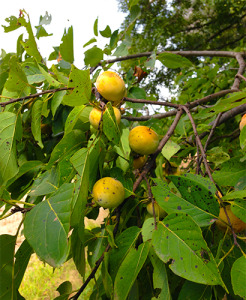 Diospyros virginiana, or commonly known as the American Persimmon, is a tree that is worth knowing about. It is a valuable food supply, and a source of wood, that is very dense and tight grained. Diospyros virginiana, hereafter called American Persimmon, generally grows to about 65 feet in height. It grows where the soil is well drained.
Diospyros virginiana, or commonly known as the American Persimmon, is a tree that is worth knowing about. It is a valuable food supply, and a source of wood, that is very dense and tight grained. Diospyros virginiana, hereafter called American Persimmon, generally grows to about 65 feet in height. It grows where the soil is well drained.
The Persimmon’s growing range is New York to Florida, in the east, and stretches west to the eastern part of Kansas down to Texas. Trees in the western extent of the growing area tend to be the largest found. Its fossils have been found in such places as Greenland, Alaska, and Nebraska.
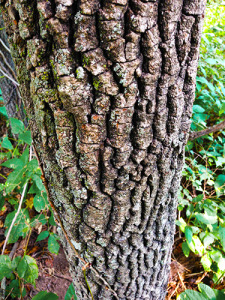 The trees will be between 30-80 feet tall, and will have a slender trunk with dark brown to gray. The bark will be deeply divided and have a scaly texture.
The trees will be between 30-80 feet tall, and will have a slender trunk with dark brown to gray. The bark will be deeply divided and have a scaly texture.
 The branches are often droopy and form a rounded canopy at the top. The leaves are oval in shape.
The branches are often droopy and form a rounded canopy at the top. The leaves are oval in shape.
The small fragrant flowers appear in May or June. The trees are dioecious, needing both male and female, to produce fruit. Wind and insects do the job of pollinating. The trees reach fruit production around 6 years of age. The fruit is globed shaped, and between 1” and 11/2” in size. The fruit is bright orange to a reddish color, and when fully ripe taking on a blueish hue. These will, at most times, have a glucous bloom covering its surface.
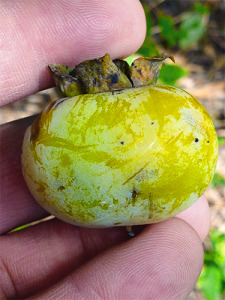 The fruit will have anywhere from 8 seeds to none. It is high in vitamin C, and very astringent, from the tannins, when green. The fruit can be eaten raw, cooked or dried. The pulp can be made into pies, breads, candy, and old style puddings. Molasses can also be made from the pulp. The seeds can be roasted for a coffee substitute, and the leaves made into tea. A Brandy is also made from the fermented pulp.
The fruit will have anywhere from 8 seeds to none. It is high in vitamin C, and very astringent, from the tannins, when green. The fruit can be eaten raw, cooked or dried. The pulp can be made into pies, breads, candy, and old style puddings. Molasses can also be made from the pulp. The seeds can be roasted for a coffee substitute, and the leaves made into tea. A Brandy is also made from the fermented pulp.
The reasons that the Woodsman needs to be familiar with the Persimmon are as follows:
- The fruit remains on the tree deep into the winter, providing an accessible food source for humans and wildlife.
- Deer are attracted to the Persimmon.
- The wood is very dense and tight grained, making it suitable for craft projects.
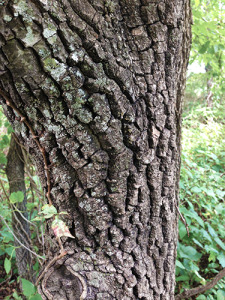 The heartwood in older trees is a true Ebony, however, trees have to reach 100 years of age to have a commercially harvestable amount.
The heartwood in older trees is a true Ebony, however, trees have to reach 100 years of age to have a commercially harvestable amount.
During the Civil War, the seeds were used as buttons. The seeds are also used to predict the type of winter by splitting them open and reading the seed leaf.
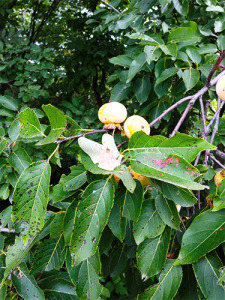 I hope the next time you are out in the woods, you’ll keep an eye out for this useful tree. If you get a chance, try the ripe fruit, you will be happy you did. Some of my fondest memories as a child, are of Thanksgiving and Christmas dinners and Grandmas Persimmon Pudding for dessert.
I hope the next time you are out in the woods, you’ll keep an eye out for this useful tree. If you get a chance, try the ripe fruit, you will be happy you did. Some of my fondest memories as a child, are of Thanksgiving and Christmas dinners and Grandmas Persimmon Pudding for dessert.
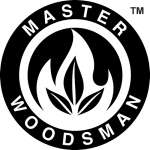

2 Responses to American Persimmon